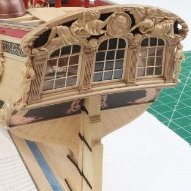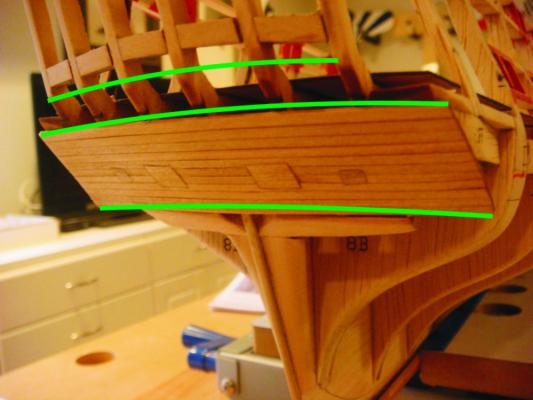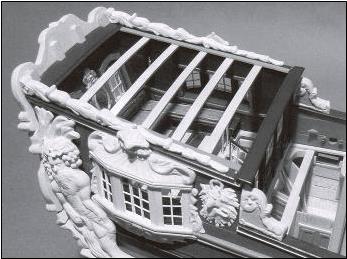-
Posts
9,637 -
Joined
-
Last visited
Content Type
Profiles
Forums
Gallery
Events
Everything posted by Chuck
-
I originally bought a Microlux mill to test my block making concepts. At 2500 rpm it was the same as the Sherline buut only about $200 cheaper. I am one of those guys who prefers to use hand tools when making parts for my models. I will take a sharp chisel over a mill any day of the week. But to mass produce parts it just wasnt a consideration so I took the plunge. After about 6 months, I had successfully set up a method for the mill to cut blocks. I did not find that the 2500 rpm was a problem at all. The Microlux is a heavy and sturdy machine. It performed well. But after 6 months I was producing 20,000 blocks per month. I was probably using the mill more often than most here would ever need. So about two months ago I sold the Microlux and bought a Sherline. It was the same speed. I still dont see a reason to have more speed. But that doesnt mean that if I eventually did upgrade it for more speed I woudnt be happy. The Sherline is actually lighter built and seems more fragile. The Microlux was a heavy machine and could take a beating....BUT The smoothness of the Sherline is far superior to the Microlux. The movements of the X and Y tables are incredibly precise and very very smooth. The movement in teh Microlux is a bit primitive and it has a lot of slop. The set up time for the Microlux took so much longer because I had to account for the slop and loose-play in the X and Y axis. You learn to adjust but the results spoke for themselves. I have had far fewer rejects and much less tear-out of the wood using the Sherline. The smooth precise operation gives you more control to maintain a consistent speed of the x and y tables....this produces a much cleaner part. The number of accessories is also better for the Sherline. Do I need more power and more speed (RPM)??? I dont really know...but the 2500-2800 rpm on the Sherline seems to be more than enough. The finish and clean surface of the wood (boxwood and Swiss Pear) tells me that the the speed is just fine. I think its important to recognize what the proper feed speed of your work should be and not rush the operations...that will give you a problem. Once again I am really abusing these machines. They are being used 4 or 5 days a week for hours at a time. My 17 year old son uses it with less care than I do...it has been holding up well and I literally make 20,000 blocks per month on it. I cut wood anywhere from 1/16" thick to 3/16" thick...the larger sizes require multiple passes with the endmills....Before making a decision I recommend visiting a friends shop to sit and use theirs and discuss the pros and cons...you have to see and feel the machine at work. Having used both brands in a short time I feel qualified to make the comparison....The Sherline is well worth the extra $200. Chuck
-
Very nicely done. That top is looking good. You work fast Dan. Hows the trigger finger? Chuck
- 241 replies
-
- queen annes revenge
- pirate
-
(and 2 more)
Tagged with:
-
Depending on what they need to be used for.....you can take some thin gauge wire and fold it in half around a drill bit the correct diameter. Then twist the two tail ends together many times which will tighten up the eye and make a screw-like pin. Slip it off the bit when you are done. The screw like tail will really hold when glued into a pre-drilled hole. There will not be any chance you could easily remove it. If you use stell wire you can get really thin stuff and make eyebolts with crazy small eyes. No monkeying around with pliers needed. Chuck
-

US Brig Syren by Gahm - Model Shipways
Chuck replied to Gahm's topic in - Kit build logs for subjects built from 1801 - 1850
Nicely done!! The cables do look a bit heavy but that is an easy fix. Chuck -
That is looking just fantastic Rusty. Chuck
- 421 replies
-
- granado
- bomb ketch
-
(and 2 more)
Tagged with:
-
Glad to see that everything arrived safely......remember to have fun with it!!!
- 45 replies
-
- syren
- model shipways
-
(and 1 more)
Tagged with:
-
You know where to find me.....3/16" is Ok but its a little wide for the brig. For a brig of this time period, 10" would be ideal. The problem with the kit is that 5/32" wide strips are not common so I had to use the smaller strips. Also with 3/16" strips you may run into problems with bending edgewise. If you are milling your own strips or spiling from wider sheets you shouldnt have an issue with 5/32" being the most accurate. That being said...it will certainly change any planking directives I may have used in the instructions. As far as the nail size...go the smallest you can find. At this scale you would need to use hypodermic needles that are very small to be in scale. They would be small 1/2" nail heads or therabouts. Th eprimary sources on that are scarce to be honest and that is my own best guess. Chuck
-
That looks so well done. Congrats!!! I do hope you enjoyed the project from start to finish. Cant wait to see the Syren start taking shape.
- 234 replies
-
- 18th century longboat
- model shipways
-
(and 1 more)
Tagged with:
-
Now that I see it at that angle...its still tough to be sure. But eaxamine the curve of that lower counter as it should mimic the bottom of the transom. The upper counter should be a consistant width when done. One thing I notice is that most folks dont create enough of a curve on the top of the lower counter. It should be curved as such to make the upper counter consistent in height. One way to check this is to place a copy of the transom from the plans....with all the carvings etc. Attach it to the stern frames so you can better see that curve at the top edge of what will become the upper counter. This will than leave an area between the lower counter and the transom for you to examine. It should be the same height and have a consistent curve to it to match that template. Hope that makes sense. I placed some green lines on your image to show the curve I think it should look like. Chuck
- 2,191 replies
-
- confederacy
- Model Shipways
-
(and 1 more)
Tagged with:
-
Looks good. Make sure you sand the tops of the sills for the stern windows level. They shouldn't slope down or up....flat and level. Otherwise the model is looking really good. Wonderful work. Try not to rush through the planking. I know that is going to be tough because mid way through...you will want it to be done. Two-thirds done and you will starting mumbling all sorts of things.
- 2,191 replies
-
- confederacy
- Model Shipways
-
(and 1 more)
Tagged with:
-

Green Graphed/scaled work bench mat
Chuck replied to Bill Hime's topic in Modeling tools and Workshop Equipment
Staples has them....any office supply store basically. -
Heres a nice review for folks....... Scratch Building the Yacht Utrecht Instructions and Plans by Gilbert McArdle Distributed by: Sea Watch Books, LLC, Florence, Oregon www.seawatchbooks.com, seawatchbooks@gmail.com There is no doubt that Gilbert McArdle has become one of the authorities of our time on the construction of models representing Seventeenth and early Eighteenth Century vessels. Mr. McArdle’s latest book outlines the ........... Open the PDF below to read the full two page review. It really gives you a thorough description if you are considering the project!! Scratch Building Utrecht.pdf Chuck
-

3D Printing - Not Just Yet!
Chuck replied to dvm27's topic in CAD and 3D Modelling/Drafting Plans with Software
Folks have added additional steps to help reduce the surface texture. It will be a few more years I suspect. Check out this article. http://www.kraftwurx.com/forum/25-how-to/572-smoothing-3d-printed-models Chuck -

3D Printing - Not Just Yet!
Chuck replied to dvm27's topic in CAD and 3D Modelling/Drafting Plans with Software
I have seen better although they are slightly larger....1:24 scale. But they are crazy expensive and I dont know what machine he uses -

3D Printing - Not Just Yet!
Chuck replied to dvm27's topic in CAD and 3D Modelling/Drafting Plans with Software
That is certainly a disappointment. My guess is that the per piece price is still pretty high for that quality as well. Better to make a few good brass masters and then have them professionally cast. Chuck -
Great to see it finally arrived...remember .....have fun with the project. Chuck
- 45 replies
-
- syren
- model shipways
-
(and 1 more)
Tagged with:
-
Yupp...something looks really off there. Either they printed your plans wrong or the templates are way off. They probably didnt set the page scaling to "none" when they printed them. I would measure the scale bar on the plans. If that is correct then simply copy that and use it. This probabloy would mean that all of your templates are printed incorrectly. Send me a PM and I can email you a pdf of the templates. But just give me your email adress. I wont have time to send it until tomorrow though. Chuck
-
I had a great time....My wife and daughter did as well. In that photo that was posted showing those 5 handsome fellows.... Ryland is on the left...I am next to him...(must cut back on the pasta)..then there is Barry, JimL , and TomR from my local New Jersey club. We really enjoyed it and I will be giving a short description of the conference at my club meeting tonight. Getting in to see the Hunley was just fascinating. You really got up close to the tank she is still soaking in. The sub wll be in that bath for another ten years. Chuck
-

Question about Model Expo's Electric Plank Bender
Chuck replied to Basic's topic in Modeling tools and Workshop Equipment
That doesnt seem right.....I would give them a call and ask for a new one... Chuck
About us
Modelshipworld - Advancing Ship Modeling through Research
SSL Secured
Your security is important for us so this Website is SSL-Secured
NRG Mailing Address
Nautical Research Guild
237 South Lincoln Street
Westmont IL, 60559-1917
Model Ship World ® and the MSW logo are Registered Trademarks, and belong to the Nautical Research Guild (United States Patent and Trademark Office: No. 6,929,264 & No. 6,929,274, registered Dec. 20, 2022)
Helpful Links
About the NRG
If you enjoy building ship models that are historically accurate as well as beautiful, then The Nautical Research Guild (NRG) is just right for you.
The Guild is a non-profit educational organization whose mission is to “Advance Ship Modeling Through Research”. We provide support to our members in their efforts to raise the quality of their model ships.
The Nautical Research Guild has published our world-renowned quarterly magazine, The Nautical Research Journal, since 1955. The pages of the Journal are full of articles by accomplished ship modelers who show you how they create those exquisite details on their models, and by maritime historians who show you the correct details to build. The Journal is available in both print and digital editions. Go to the NRG web site (www.thenrg.org) to download a complimentary digital copy of the Journal. The NRG also publishes plan sets, books and compilations of back issues of the Journal and the former Ships in Scale and Model Ship Builder magazines.




